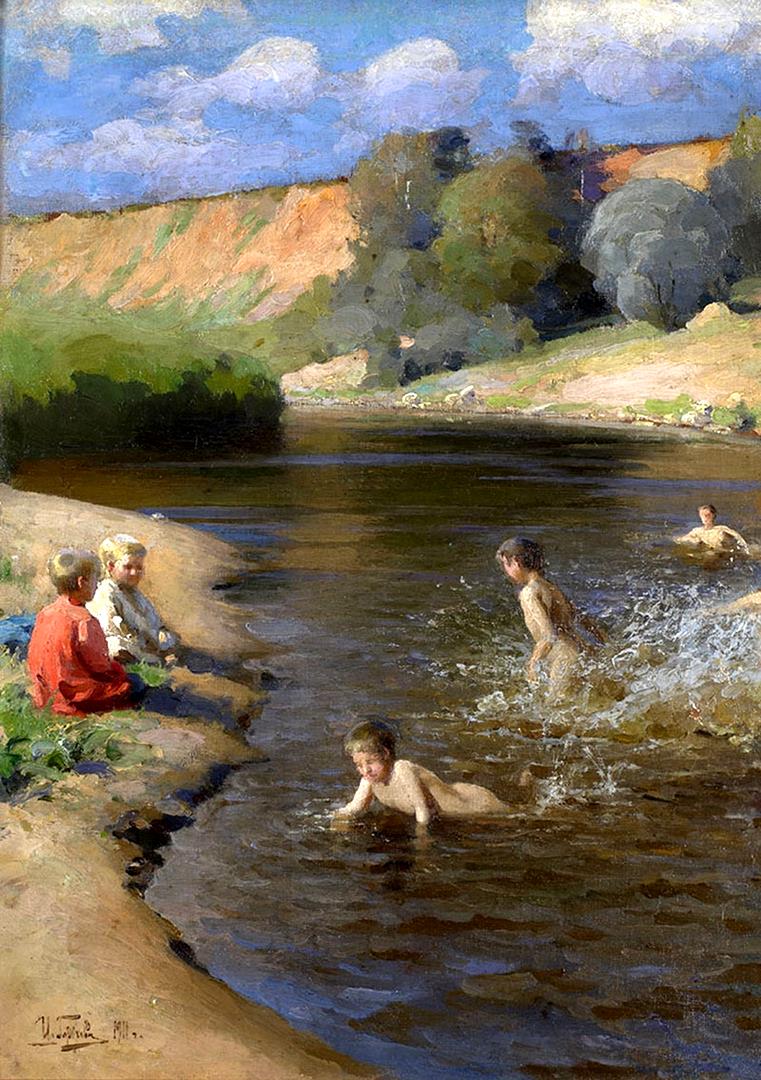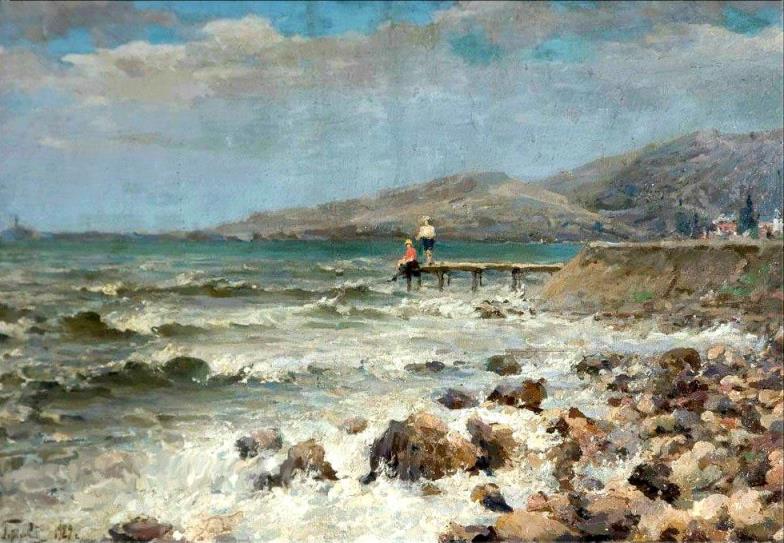Paintings of Artist Ivan Gorokhov
Ivan Lavrentievich Gorokhov ( художник Иван Горохов ) was born on January 23, 1863 in the village of Beli, Mozhaisky district of the Moscow province of the Russian Empire, into the family of a former serf peasant. The childhood of the future painter passed in his native village Beli near Mozhaisk. The boy's father was able to learn to read and write from a local priest, and he himself studied reading and writing with his son. From trips to the market, I always brought my son cheap books.
"Soap Bubbles", early XX century, oil on canvas private collection.
Once Ivan took paper and a pencil and tried to sketch a picture he liked. From that day on, drawing became his favorite pastime. The boy dreamed of seriously studying painting, but his father, a peasant who worked for a local landowner, could not financially support his son's passion for painting.
The rumor about a gifted peasant boy quickly spread throughout the area. The local landowner Vladimir Karlovich von Meck also learned about him. Vladimir Karlovich bought several drawings of the young artist for a song and showed them to the famous pianist Nikolai Grigorievich Rubinstein, who was visiting him at that time.
Rubinstein, being a person well versed in the visual arts, immediately recognized the little artist's undoubted natural talent, and suggested to his friend that with proper training, an outstanding painter could turn out from a local nugget.
Rubinstein and von Meck offered Ivan to enter the Moscow School of Painting, Sculpture and Architecture, promising help in the arrangement and financial support for the entire period of study.
In 1874 Ivan Gorokhov became a volunteer at the Moscow School of Painting, Sculpture and Architecture, and since 1880 - a full-fledged student. His painting teachers were the famous Russian artist and teacher, master of genre painting Illarion Mikhailovich Pryanishnikov (1840-1894) and an outstanding Russian itinerant artist, painter and graphic artist, teacher, master of genre scene, academician Vladimir Egorovich Makovsky (1846-1920 ). Communication with fellow students Konstantin Korovin (1861-1939), Valentin Serov (1865-1911), and Isaac Levitan (1860-1900) helped him to comprehend the depth of realistic embodiment of life. This picture
In 1886 Ivan Gorokhov graduated from the College with honors. The artist's diploma work was the later famous painting "Convalescent", executed in the best traditions of late Wanderers.
Gorokhov showed Konstantin Yegorovich Makovsky, who had arrived at that time in Moscow from St. Petersburg. As the artist himself recalls: “He looked at her for a long time, made some comments. I asked him, among other things, if I should complete my education at the Academy of Arts. To this he resolutely objected that it makes no sense for me to go there, that I am a fully formed artist and a trip to the academy would be a waste of time for me ... "
The dreams of the newly-made artist to continue his professional career in Moscow were not destined to come true. In the recent past, a village boy, without serious support from influential Muscovites, simply did not receive orders. Nobody knew him and nobody "promoted" him among the wealthy Moscow citizens. The financial situation worsened every day and Gorokhov was forced to leave such inhospitable Moscow and return to his native village.
Returning from Moscow to his homeland, the painter devotes himself entirely to creative work. However, even here the need does not let go of our hero. He did not have a real workshop, he had to go to Moscow for paints and canvas, it was expensive to transport paintings to exhibitions, and besides, he had to support his family.
As the biographer Gorokhov (N. Musienko) would later write: “Ivan Lavrent'evich was much less fortunate in terms of fame than many of his fellow artists. As a rule, he sold his works directly from exhibitions or art auctions to private collections, and now there is no information about the fate of most of them. " Despite the difficulties and hardships, the artist regularly participates in numerous metropolitan and provincial exhibitions. And already since 1893 Ivan Lavrent'evich Gorokhov became an exhibitor of the "Association of Traveling Art Exhibitions".
Gradually, the long-awaited recognition came. At the XXI exhibition of TPHV Gorokhov demonstrates his canvas "Peasant Children". “My picture,” Ivan Lavrentievich recalls later, not without pride, “was not only accepted, but soon bought from the exhibition, and newspaper critics noted it as a talented and outstanding piece of technology. And AF Marks, the publisher of the Niva magazine, offered me 50 rubles in writing and a free mailing of the magazine with all attachments for the right to reproduce it for a year.
Ivan Lavrentyevich Gorokhov's paintings are mostly small genre canvases dedicated to village life. Their plots are simple and simple.
ylivy, and the images of some are very close to Nekrasov's. These are the paintings: "Forgotten Sacrum", "Washed Down", "In the Hut", "Children at School", "The Seamstress", "In the Smithy", "Ice Carriers", "The Death of the Nest", "Tornadoes. They mishandled ”,“ Nest ”,“ At the bedside of a sick husband ”,“ Around the world ”and many others. The artist's brushes belong to masterful paintings with views of old Mozhaisk. Some streets, buildings of the city, now not preserved, we can see only near Gorokhov.
In 1897, a great misfortune happened in the artist's life: a fire destroyed almost the entire village of Beli, including the Gorokhovs' hut. They managed to save only an insignificant part of the property and the paintings prepared for the next exhibitions. The artist and his large family are forced to move to Mozhaisk, where they buy a house in installments.
The artist's family continues to feel the need: "I was forced to paint such pictures that would be liked by the bourgeois public and were suitable for decorating living rooms ... This made me unbearably hard, bitter, insulting." But even in these conditions, Ivan Lavrent'evich does not leave his favorite topic - the life of the common people. Often on his canvases of that time, fires blaze as a memory of the experience of the death of his native nest.
In 1903, Ivan Lavrentievich buys a chicken hut that was being sold for demolition in one of the suburban villages, moves it and puts it on the site near his house, turning it into a workshop. Many of his works were subsequently written here. Here he often brought sitters - village children, men and women. In addition to artistic activities, Gorokhov was engaged in teaching - from 1905 to 1930 he taught an art class at the Mozhaisk Real School.
The October Revolution of 1917, Ivan Lavrentievich, a supporter of law and order, naturally could not and did not accept. On the very eve of the civil war, he writes: “As a provincial who is not developed in political matters, it seems to me that thanks to the struggle of parties and the propaganda of aggressive tendencies among workers and peasants by the communists, insubordination to the authorities and arbitrariness, there is some kind of chaos among the people, licentiousness. And from this our country is shaken, ruined, and desires terribly for the country's future ”.
The difficult living conditions that developed during the years of the civil war, when Ivan Lavrentievich had to direct all his efforts to the elementary salvation of the family from hunger, tore Gorokhov away from active creativity. But even under these conditions, he continued to teach at the local real city school. Among his students was the future People's Artist of the USSR, the classic of Russian art of the 20th century, Sergei Gerasimov.
After the October Revolution, Gorokhov gradually began to work in the genre of socialist realism - he painted portraits of the leaders of the young state of workers and peasants V.I. Lenin, A. V. Lunacharsky, paintings on the theme of the civil war and the construction of a new society.
Unfortunately, most of these canvases have not survived to this day, since they were destroyed by the occupation troops who entered the captured Mozhaisk in 1941.
By a lucky coincidence, about two dozen of the artist's canvases were nevertheless evacuated by members of the artist's family, and today they are in the house of the descendants of Ivan Lavrentievich on Herzen Street in Mozhaisk.
In 1920, Ivan Lavrent'evich suffered from typhus. Having recovered from his illness, in 1924 he made a trip to the Crimea. From there, the painter brought many studies and sketches for future paintings.
In the last years of his life, Ivan Lavrent'evich was ill a lot, He left teaching, but continued to create. He was not forgotten by his Moscow fellow artists, who often visited in Mozhaisk. The question of holding his personal exhibition in Mozhaisk and awarding him the title of academician of painting was actively discussed. He was given a personal pension, however, it happened too late.
Ivan Lavrentievich Gorokhov died after a serious long illness on October 6, 1934 in Mozhaisk, where he was buried in the city cemetery.












































muy lindas todas las pinturas traro de la vida cotidiana
ردحذف